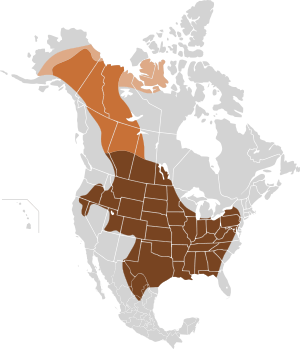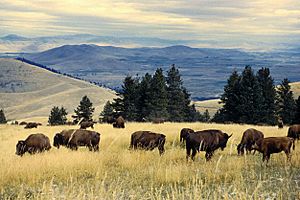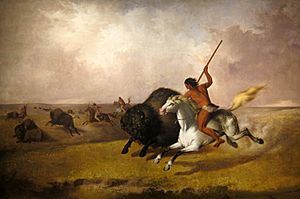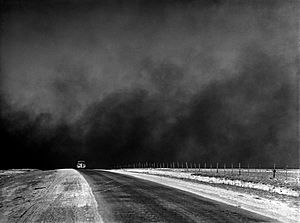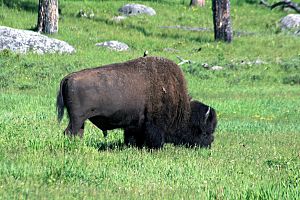Great bison belt facts for kids
The Great Bison Belt was a huge area of rich grassland that stretched across North America. It went all the way from Alaska down to the Gulf of Mexico. This amazing natural area existed around 9000 BC.
This belt was special because of its short grasses. These grasses grew well with spring and early summer rainfall. They kept their moisture deep in their roots. This meant that grazing animals, like bison, could find healthy, nutritious food even in the fall.
The short grasses were perfect for bison. They gave the bison all the food they needed to grow strong and healthy. This was different from other animals that lived after the Ice Age. The Great Bison Belt was also very important to the Paleo-Indians who lived on the Plains. Around 8500 BC, they started focusing on hunting bison for food.
Contents
Early History of the Bison Belt
About 50 to 75 million years ago, hot melted rock pushed up to form the western mountain ranges. This included places like the Black Hills. Then, about 10 million years ago, other natural forces shaped the rest of the Great Bison Belt. This became the largest natural area of its kind in North America.
When the Ice Age ended around 10,000 years ago, the weather became warmer and drier. This made the area perfect for grasslands and other plants to grow. Before people changed things, the Great Bison Belt covered most of the present-day United States. It also included parts of Canada and Mexico. It stretched from Southern Mexico to Northern Canada. It went from California in the west to Virginia in the east.
Environment of the Grasslands
The Great Bison Belt usually had low rainfall. It often received less than 610 mm (24 inches) of rain each year. In some drier spots, the yearly rainfall was even less than 406 mm (16 inches). The weather here was also very unpredictable. Dry periods could quickly change to times of heavy rain.
There were also big differences in the environment from one region to another. The southern plains, like the Texas Panhandle, often had stronger winds and less rain. This was compared to northern areas like North and South Dakota. Because of this, droughts happened more often in the southern parts of the Great Bison Belt. Some droughts were so bad that early explorers called it the Great American Desert.
The Canadian prairies are similar to the American plains grasslands. However, farmers later cleared many trees there. They turned much of the grassland into farms. The area from Northern Alberta to Alaska is mostly woodlands. This region supported smaller groups of wood bison that did not migrate.
The grasslands of the western plains were the heart of the Great Bison Belt. They were mostly made up of blue grama (Bouteloua gracilis) and buffalo grass (Bouteloua dactyloides). These grasses have deep, thick roots. They hold a lot of water. This helped them survive big changes in the environment. The natural world of the Great Bison Belt was defined by constant change, not by staying the same.
The Role of Bison
The bison is the largest land animal in North America. It can weigh up to 900 kilograms (one ton). Long ago, bison lived all across the Great Bison Belt. English settlers first saw bison near the Potomac River.
At their peak, between 30 and 40 million bison roamed the Great Bison Belt. Bison are very good at controlling their body temperature. This helped them survive even the harshest weather. The short grasses provided the perfect diet for so many bison. Humans had already caused many large animals in North America to disappear. This meant bison didn't have to compete with other huge animals for food.
Bison droppings and their grazing helped keep the grass healthy. They also stopped taller grasses from taking over. The Great Bison Belt supported many different kinds of plants and animals. For example, there were so many bison that by the early 1800s, about 1.5 million wolves lived in the Great Bison Belt. They mostly ate bison.
How Humans Changed the Bison Belt
Humans have changed the landscape and ecosystems of the Great Bison Belt for thousands of years. They removed trees, brought in new plants, hunted animals, and planted crops. However, the biggest changes happened in the last 400 years.
Bringing livestock from Europe completely changed the natural environment. The Spanish brought horses in the 1500s. These horses spread across the plains through complex trade routes. Horses were well-suited for the Great Bison Belt's environment. They quickly grew in number.
Plains Natives eagerly started using horses. They used them to hunt bison herds all year round across the Great Bison Belt. Some societies changed a lot. They became semi-nomadic, meaning they moved around with the bison. By the early 1800s, about 60,000 Plains Natives owned between 300,000 and 900,000 horses. There were also over two million wild horses.
The horses put pressure on the bison in two ways. First, they ate the same grass as the bison. This meant there was less food for the bison. Second, horses helped the Plains Natives kill bison much faster than before.
By the 1840s, Plains Natives were killing bison at a faster rate. They killed about 500,000 bison for their own food. They also killed 100,000 more to trade with American merchants. At the same time, trees were being cut down in the north and east. The cattle market was also growing in the south. All of this put even more pressure on the bison.
Finally, commercial hunters in the 1870s hunted bison almost to extinction. Between 1872 and 1874, hide hunters killed over four million bison. During the same time, Plains Natives killed over one million.
The destruction of the bison had serious effects on the Great Bison Belt's ecosystems. The tough short grasses were replaced by less stable but faster-growing tall grasses. Cattle soon took the place of bison as the main animals eating the grasslands. By 1900, about 30 million livestock animals lived in the Great Bison Belt.
The cattle quickly ate too much grass in large parts of the Great Bison Belt. The situation was so bad that the amount of land needed to feed cattle increased tenfold. The cattle started a process of stripping the plains bare. This changed the ecosystems of the west.
The last major change to the Great Bison Belt was farming. The grasslands soon proved to be a good place for growing wheat. Farmers removed the grass and soil to make room for farmland. This practice harmed the ecosystems. It led to a huge increase in grasshoppers and other pests.
The destruction of the grasslands was widespread. In the southern plains of the United States, three million acres of grassland were reduced to just 450,000 acres by 1926. This destruction led to the Dust Bowl in the 1930s. It was one of the worst environmental disasters in history. By 1935, 850 million tons of topsoil had blown away. The dust was carried as far as the Atlantic Ocean. Since then, the Great Bison Belt has been helped by government efforts to save the soil. However, the grasslands have never fully recovered.
The Great Bison Belt Today
The Great Bison Belt continues to be a major farming area for North America. There is farmland to the east and cattle ranches to the west. Bison numbers have grown a little in Yellowstone National Park. Their population reached between two and four thousand by the 1990s. With wolves being brought back to the park, bison are once again part of a healthy and complex ecosystem.


